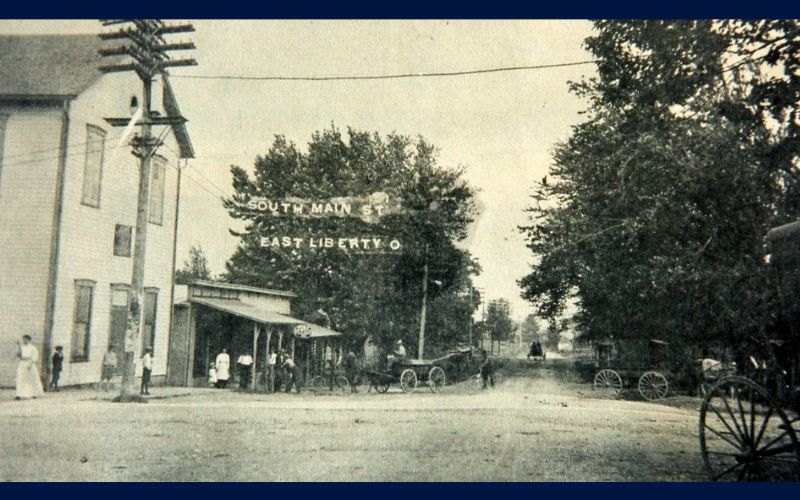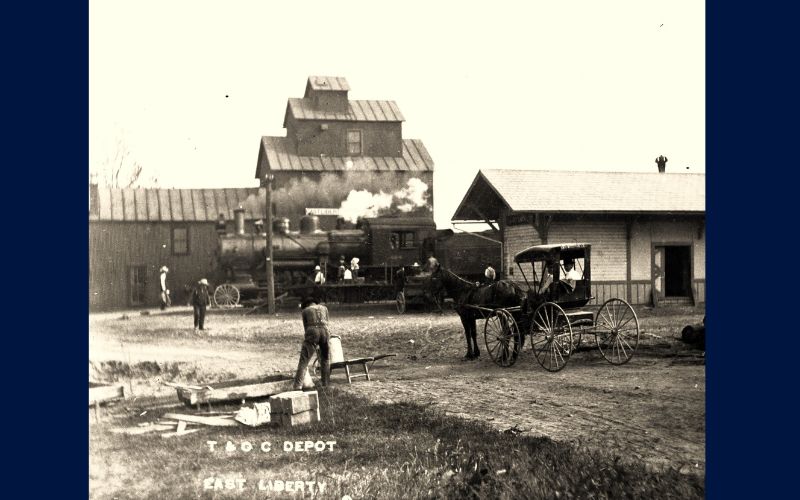By: Mary E. Mortimer
The village of East Liberty was first known as Garwood’s Mill. Around 1810, John Garwood and his five sons moved from Virginia to Logan County and built a grist mill on Otter Creek. Garwood, however, was not the first settler to the area. Dr. Phebe Haines Sharp and her husband, Job, arrived about 1801. As a young lady, Phebe Haines took preparatory classes in New Jersey and then went on to medical school in Philadelphia. She married Job Sharp in 1780. They built a homestead on land between what is now known as East Liberty and Middleburg. After they settled in, Dr. Sharp traveled by horseback treating anyone who needed medical assistance in the vicinity.
As news of Garwood’s mill spread, a settlement began to grow close to the flourishing mill. The area soon became known as “Garwood’s Mill”. Garwood made several improvements to his mill until he was able to grind 150 bushels of grain in 24 hours. The grist mill was an important part of everyday life. It ground grain for wheat flour and corn meal.
A one-room school was built around 1815 with David Reed, and later John Garwood, as teachers. The Methodist Church was organized in 1829. They built a log church in 1835 and used it until a new larger church was constructed in 1850.

By 1830, the mill was patronized by so many people that a road was built from Urbana to Garwood’s Mill that continued to Big Springs. Later, a road was built from Garwood’s Mill that went to Walnut Grove.
Perry Township was formed in 1830, and East Liberty was laid out in March 1834 by John Bower on survey 4689. The first dwelling was built by Josiah Austin Sr. and the second residence by John McCally. Early businesses included a dry goods store, general store, blacksmith shop, harness shop, shoemaker, tannery, and tavern. The East Liberty Post Office was established in 1836.
East Liberty has always been known for its abundance of fresh flowing water. Many homes in East Liberty and the surrounding area have artesian wells. The pure running water was one of the attractions and necessities for the early settlers.
The Bellefontaine Gazette reported on November 17, 1838, “Four years ago, a well was dug in the village by John Mathis to the depth of 33 feet when a large stream of water burst in a few feet from the bottom of the well and such was the rapidity of its flow, that less than three minutes it filled the well nearly to the top. As it approached the surface, it rose gradually slower but ran over the top and still continues to run a large stream today.”
A Presbyterian Church was built in 1875. After the building was abandoned in 1885, the Christian Church purchased the structure. They razed the building in 1911 and constructed a new cement block church. The Christian Church became the Church of Christ in the 1950’s.
In 1882, Alonzo Skidmore started the Central Ohio College in East Liberty. The school offered science classes in physics, botany, and geology, as well as literature courses, business and commercial classes, music, art, and a normal school for teachers. Tuition was initially $10 for twelve weeks. By the early 1890’s the school enrollment began declining and the college was shut down in 1893. The village purchased the building in 1894 and used it as a three-year high school until 1913.

In 1897, the Toledo & Ohio Central Railroad came to East Liberty. With the railroad and depot being on the direct line from Bellefontaine to Columbus, the town’s prosperity greatly increased. Passenger service ran twice a day and as many as 20,000 bushels of grain, mostly wheat, were shipped yearly. The railroad offered residents the opportunity to ride the train to Bellefontaine to shop for items that were not available in East Liberty.
The Hamilton Bank was founded in 1899 by F.C. Hamilton, son of J.C. Hamilton, East Liberty’s first resident physician. Hamilton loaned money from his office before getting a loan license and establishing the bank. He incorporated the bank a few years later. The bank was closed around 1938.
East Liberty published two newspapers, “The East Liberty Star” was founded in 1899 by John Pegg and published for about one year. The second newspaper was “The East Liberty Echo”. It was published by Howard H. Harvey starting in 1908 and ran until about 1920.
The East Liberty Cement Roofing Company was incorporated in April 1906. The company built several buildings in the East Liberty including the Methodist Church, Christian Church, and a home on Hamilton St. They made and sold cement fence posts, cement roofing shingles, and cement building blocks.
In 1913, Ernest H. Harding bought the former Central Ohio College building and established the Harding Machine Co. He installed one automatic screw machine, one hand screw machine, a drill press, a lathe, a 15-horsepower gasoline engine, and a few machine tools. He hired three “helpers” to get the business started. In 2006, Harding Machine Co. became a division of Global Precision Parts.

East Liberty is a village rich in history. Over the years it has had many businesses and seen a lot of changes but still thrives with a population of about 370 people.
Information from “Why Small Towns Produce Big Character, The History of East Liberty, Ohio, One Small Town with Big Character” by Janet Akey Blank.
Visit the Logan County History Center at 521 E. Columbus Ave., Bellefontaine, Ohio 43311, to learn more interesting aspects of Logan County History. The History Center is open for tours Wednesday – Sunday from 1:00 pm to 4:00 pm.
















